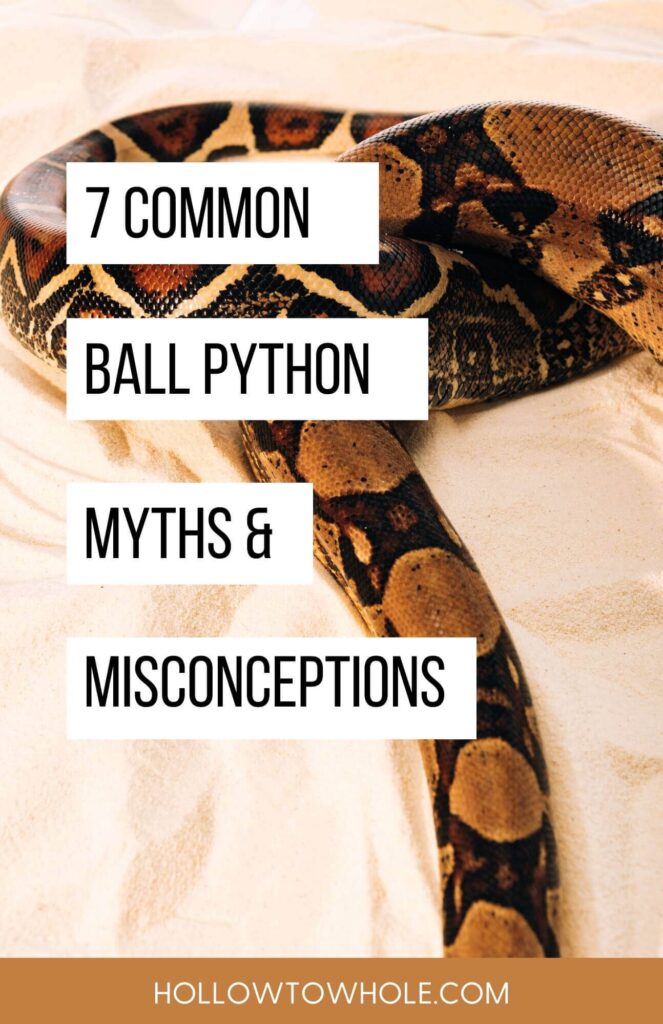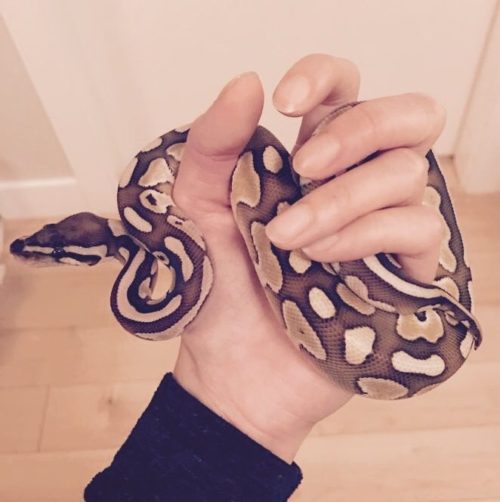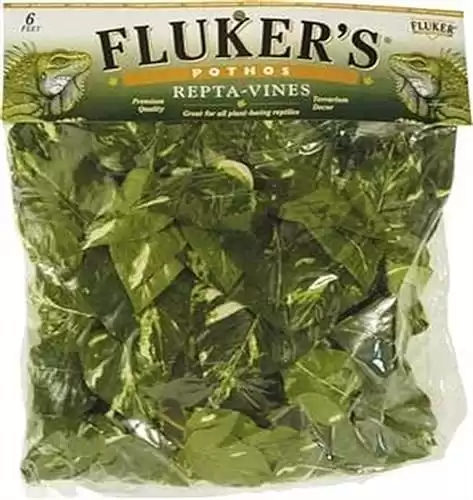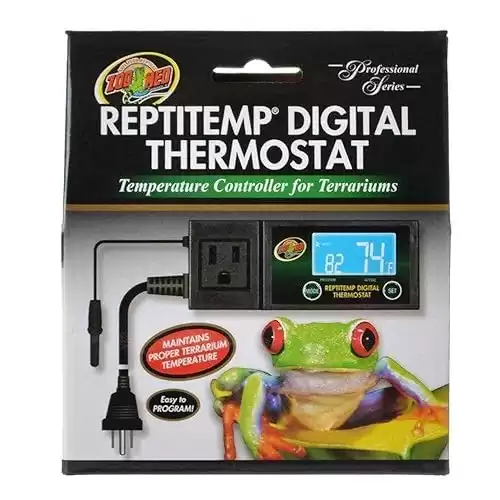7 Common Ball Python Myths & Misconceptions
Ball pythons are amazing creatures and give great reward when properly taken care of. They are docile, low maintenance and add a touch of nature right inside your home.
From personal experience with my ball python (Louie), 7 year old male, I’ve gained some insight on the common myths and misconceptions of these fantastic exotic pets.
**This post contains photos that some may find disturbing**
Save this pin for later!

Disclosure: This post may contain affiliate links. If you click and purchase, I may receive a small commission, at no extra cost to you. As an Amazon Associate I earn from qualifying purchases. Learn more here
Post Last Updated: May 6, 2024
7 Common Ball Python Myths & Misconceptions
Below are my own experiences which may vary from yours.
Do your own research, cross reference and apply ideas that work best for you and your ball python as they are all unique.
Always consult your veterinarian or breeder if you need more help!
1) Keep Them In Small Enclosures
Many sources will tell you it’s fine to keep an adult ball python in a 28 quart plastic tub (PS. the link is for a pack of 10 plastic tubs. You don’t need 10 unless you’re a breeder or something. You just need one) or a small glass tank and that large enclosures will stress out them out.
I found this to be incorrectly stated or at least some more clarification is needed.
Ball pythons like tight spaces with lots of hides and coverings to climb and explore. You can keep an adult ball python a smaller enclosure as long as they have enough room to stretch. Any enclosure size should allow your ball python’s body to fully stretch out or at least an “L” shape.
Large enclosures with tons of open space make them feel exposed; therefore leading to stress.
If you have a large enclosure, as long as you provide tons of hiding spots, caves, leaves, driftwood etc., your ball python will thrive (I cannot speak to hatchlings, as I have no experience with them).
I used to keep Louie in a 28 quart plastic tub when I first got him at 7 months. He had tons of toilet paper rolls to slither through and he would come out every night and explore.
When he became too long for the tub, I upgraded to a 40 gallon glass tank. I instantly noticed a huge change in behavior. He was much more active, climbing the wooden branches, slithering through leaves and coming out more often and longer.
Some say, “A hiding ball python is a healthy python”. Although that’s true to some extent, realistically, that’s not how they behave in the wild.
In their natural habitat, you’ll often find ball pythons in trees and hanging from branches.
Based on my own understanding of Louie and his personality, there’s much more mental and physical stimulation which provides a healthier and happier lifestyle for him.
Shopping online? Why not earn money while you’re at it!
- Get cash back when you shop online
- 750+ stores including: Temu, Amazon, Wayfair, Old Navy, Sephora, Groupon, Aldo, Sport Chek, Macy's, Coach, Spanx, Walmart and more
- Get paid to shop for things you’re already buying
- Join for free & get $30 cash bonus today
2) Snakes Are Slimy
Many people think reptiles and amphibians are very similar but the truth is, they’re actually very different species.
Most snakes are very smooth and soft.
Some snakes like the Hognose and Garter snake have keeled skin which is a ridge that goes down the middle of each scale, some almost to the tip, making them feel rough.
Most amphibians (frogs, salamanders, newts, toads, etc.) have a thin lubricated layer that helps them breathe which is where the slime comes from.
Ball pythons do not have this.
3) Feed Them In Another Enclosure
Personally, I don’t see any reason to remove your ball python every time you feed it.
The idea behind this is some believe feeding inside their usual enclosure will lead to aggression overtime and they may strike your hand thinking it’s food whenever you put your hand in there.
From personal experience, I’ve never had Louie strike at me when I change his water, spot clean, fix his hides or place my hands in there for any reason.
Unless you’ve been handling a rat or you only open the lid to feed them, they generally have no reason to strike you.
It should be noted that keeping a consistent feeding schedule is very important.
For a period of time, Louie’s feeding schedule kept changing and this led him to become more alert, always quickly slithering out when I opened the lid, possibly thinking I might feed him.
When I got him back on a consistent feeding schedule, that behaviour disappeared. So always be consistent!
4) They Will Eat You Or Your Pet
Have you heard of that story of a snake who slept beside its owner every night to size her up and get ready to eat her?
This silly myth is a popular one but not true at all.
Ball pythons are opportunist feeders meaning they’ll eat almost every chance there’s prey available.
In the wild, they won’t have the opportunity to lay beside a rabbit for a few nights to see if they can eat it. If they see that rabbit, they’ll strike when they have the chance!
Ball pythons should be fed prey that’s roughly the size of their girth (the widest part of their body). However, they’re able to eat up to 1.5 times their body weight.
Eating prey too large will cause regurgitation, gut impaction and sometimes even bursting to death. For the most part, they know that by instinct.
Larger species like the Burmese python can get up to 23 feet and weigh up to 200lbs eating much larger prey, in this case, your pets may be at risk if the python is starved.
However, ball pythons in captivity are conditioned to mainly eating rodents and really have no desire to eat cats, dogs, birds or even you.
I wonder what my pet named me?
5) They Kill By Suffocation
It’s been a long time belief that constrictor snakes wrap themselves around their prey, squeeze and suffocate or crush them to death.
In 1994, a herpetologist didn’t believe killing by suffocation made sense as the prey would take much longer to die (minutes rather than seconds). He believed the constricting pressure would cause cardiac arrest instead.
It has taken 20 years to prove this theory correct after Dr. Scott M. Boback and his team put this to the test.
A ball python’s main goal of wrapping themselves around their prey is to stop blood circulation causing a lack of blood flow to the brain and heart which ultimately kills the prey.

6) Easy Beginner Snake
Ball pythons have been noted as great beginner snakes for anyone getting into this wonderous world.
However, I slightly disagree.
Yes, they’re docile, low maintenance and for the most part, relatively easy to care for considering you have their husbandry requirements on point.
They’re not as forgiving when humidity and temperature levels are off and as beginners, many tend to make mistakes especially if you don’t have the right equipment.
|
Description: Used to measure the direct temperature of the heat mat inside the enclosure. An absolute must-need to prevent your ball python from getting burned. |
Description: Used to measure the overall temperature and humidity of the enclosure to make sure it's in the proper range requirement. |
Description: Used to control the temperature of the heat mat. An absolute essential item to prevent the heat mat from overheating. |
Description: Used to provide a warm side heated area for your ball python as they are cold-blooded and reply on an external heat source to survive. |
|
$16.99
|
$18.806
|
$39.119
|
$26.99
|
Used to measure the direct temperature of the heat mat inside the enclosure. An absolute must-need to prevent your ball python from getting burned.
Used to measure the overall temperature and humidity of the enclosure to make sure it's in the proper range requirement.
Used to control the temperature of the heat mat. An absolute essential item to prevent the heat mat from overheating.
Used to provide a warm side heated area for your ball python as they are cold-blooded and reply on an external heat source to survive.
These inconsistencies can lead to hunger strikes and respiratory illness.
I’ve experienced this with Louie.
During colder months, I struggled with consistent warm temperatures and stable humidity.
Sometimes the humidity was too high mixed with cold temperatures which led to respiratory illness and vet bills.
They’re also notorious for being picky eaters; caused by incorrect husbandry or purely prey preference and environment.
For months, Louie would strike at the rat, drop it and not eat it. Through trial and error, African Soft Furs became his only preference for about a year.
He would also only eat if I covered up all sides of his enclosure, probably because of my four cats.
Up until recently, he began eating any type of rat and also ate out in the open while all my cats watched.
There are many other beginner snakes (corn snake, kingsnake, milkshake or Kenyan sand boas) that are easier to take care of.
In my opinion, ball pythons are intermediate level.
7) They Only Strike When Coiled
Ball pythons are incredibly strong, fast and flexible and can strike in almost any position.
When they’re stretched out, they’re vulnerable and can easily be attacked or picked up by predators.
Coiling is a defense mechanism.
Typically, you’ll see them coiled when they feel threatened. They may back up into a corner or something near by and use this as support to lunge themselves forward extending up to 2/3 their body length.
To tell if a snake is going to strike, watch their tail.
They’ll slowly tighten the back end into an “S”, with their head following your every move.
They’ll look tense, maybe panting or breathing heavily. Some ball pythons will puff up their body to make themselves look larger.
Thanks for stopping by 
Ball pythons are all unique and it’s good to know their personality and triggers. Always treat them with respect.

Did you like this post? Save this pin!



















Jason
March 2, 2022My ball python did eat my pet button quail and parakeet.
I had taken in the quail from the outdoor aviary as it was attacked by another quail. It was in a large tub in our store room to recover along with a young budgie that I was handfeeding. The snake also lives in the store room on top of the fridge where its warm. He got out of his enclosure (never escaped before). When I came in the next morning I thought the quail and budgie had escaped and while looking for them I found my Ball Python curled up under the shelving unit with a huge fat lump in his middle. He had eaten the quail and budgie!!! There were feathers of the quail under the shelf where he was.
Samantha Phan
March 3, 2022Omgosh, that must have been so terrifying for you! I know they are such good escape artists. When my ball python was in the tub still, I had to put locking clips all around and weigh it down with sand bags so he couldn’t push open the lid. How big was your ball python?